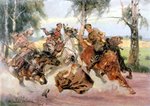The advance of the Red army 1920.
Until the spring of 1920, Poland was pushing or at least holding the Bolsheviks back. By the summer of 1920 however, the Bolsheviks began to gain strength as they were winning their civil war in Russia. By the summer of 1920, the Bolsheviks were advancing into Poland. It indeed looked as if Poland would be totally defeated. Fearing a total Bolshevik victory, the Western Allies (most notably France) begged Pilsudski to accept peace with Lenin, thereby granting Russia much territory (the Curzon Line). Pilsudski refused, and the Red Army approached Warsaw by August. Peace overtures made by Lenin were not sincere. Lenin felt that he had already won the war and would soon be able to continue the Bolshevik Revolution westward. Pilsudski knew that Lenin could not be trusted.
The Battle of Warsaw, 1920.
Between the 13th and 16th of August, 1920, a battle raged in and around Warsaw between Polish and Bolshevik forces. At stake was the future of Poland as well as the future of Europe. Red Army commanders made a tactical error when a large part of their force diverted north of Warsaw in order to cut Polish supply lines from the Baltic Sea. Pilsudski had set a trap and sprung it, taking full advantage of the Russian error. The result was the diverted Red Army force itself became cut off from their supply line, and the remaining Red Army force was decimated. General Wladyslaw Sikorski commanded a force (including some French tanks) that defended the city of Warsaw. This turn in the tide was regarded by many as a miracle, and became known as the "Miracle on the Wistula". So badly defeated was the Red Army, that it began a general retreat on all fronts. The Polish forces pursued the retreating Red Army, defeating them again at the Niemen River in September. Sikorski had chased the Red army with some armour, showing that tanks could play a role in rapid advances on the battlefield (a lesson that Heinz Guderian used later, during WW II). On October 12, 1920, an Armistice was signed, ending the fighting.
More informations:
Battle Of Warsaw
Until the spring of 1920, Poland was pushing or at least holding the Bolsheviks back. By the summer of 1920 however, the Bolsheviks began to gain strength as they were winning their civil war in Russia. By the summer of 1920, the Bolsheviks were advancing into Poland. It indeed looked as if Poland would be totally defeated. Fearing a total Bolshevik victory, the Western Allies (most notably France) begged Pilsudski to accept peace with Lenin, thereby granting Russia much territory (the Curzon Line). Pilsudski refused, and the Red Army approached Warsaw by August. Peace overtures made by Lenin were not sincere. Lenin felt that he had already won the war and would soon be able to continue the Bolshevik Revolution westward. Pilsudski knew that Lenin could not be trusted.
The Battle of Warsaw, 1920.
Between the 13th and 16th of August, 1920, a battle raged in and around Warsaw between Polish and Bolshevik forces. At stake was the future of Poland as well as the future of Europe. Red Army commanders made a tactical error when a large part of their force diverted north of Warsaw in order to cut Polish supply lines from the Baltic Sea. Pilsudski had set a trap and sprung it, taking full advantage of the Russian error. The result was the diverted Red Army force itself became cut off from their supply line, and the remaining Red Army force was decimated. General Wladyslaw Sikorski commanded a force (including some French tanks) that defended the city of Warsaw. This turn in the tide was regarded by many as a miracle, and became known as the "Miracle on the Wistula". So badly defeated was the Red Army, that it began a general retreat on all fronts. The Polish forces pursued the retreating Red Army, defeating them again at the Niemen River in September. Sikorski had chased the Red army with some armour, showing that tanks could play a role in rapid advances on the battlefield (a lesson that Heinz Guderian used later, during WW II). On October 12, 1920, an Armistice was signed, ending the fighting.
More informations:
Battle Of Warsaw

